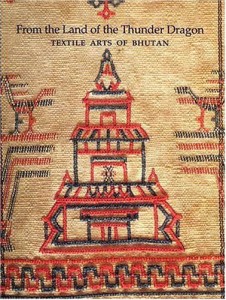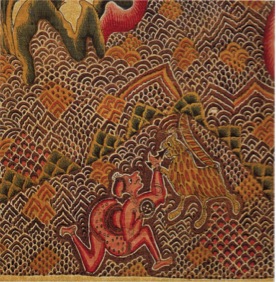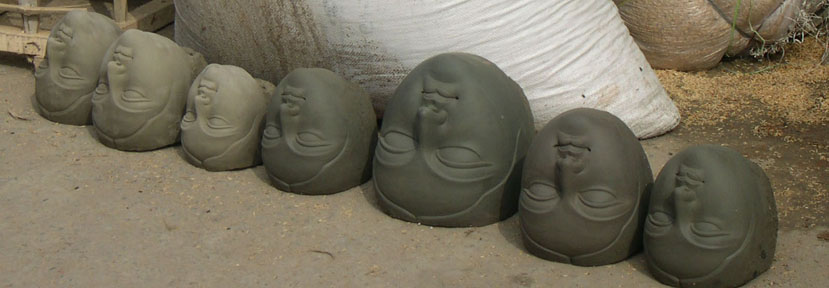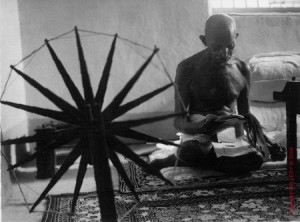The visual splendor and sensuous feel of handmade cloth captivate. Considering how these qualities are imparted from the minds, hearts and skilled hands of spinners, dyers, weavers and embroiderers has continuously enriched my experience of viewing and handling cloth and made the study of textiles irresistibly appealing. Knowing that cloth brims with meaning for those who make and use it fueled an ambition to understand how cloth is integrated into people’s lives across the globe.
I learned the power of cloth by studying how Mahatma Gandhi deployed hand spinning and wearing homespun cloth as key instruments in his program for achieving India’s self-sufficiency and freedom. My take on Gandhi’s program was first presented in “Gandhi and Khadi: The Fabric of Indian Nationalism,” published in Cloth in Human Experience (1986). I continued to be fascinated with Gandhi’s insights into the political potency of making and wearing cloth. In 1988 I focused on the role of spinning in Gandhi’s program in “Spinning Independence” for the volume Making Things in South Asia. Most recently, I presented “Producing Freedom: Khadi as Theater” In Mantles of Myth: the Narrative in Indian Textiles, a symposium held in Jaipur in 2005. Papers from the conference are now in press. Full references to these and related publications can be found here.

From the Land of the Thunder Dragon: Textile Arts of Bhutan (Serindia and Peabody Essex Museum, 2008) is available from Amazon and the Peabody Essex Museum Shop
At the Peabody Essex Museum, I curated a remarkable collection of textiles from Bhutan built in the early 1980s by museum patron and donor Jane Phillips. After meeting numerous specialists who came to view the museum’s holding, it became clear to me that the moment had arrived for a major presentation of Bhutan’s textile art. I invited Diana K. Myers to join me as co-curator of the exhibition and co-editor for the accompanying book. In 1994 From the Land of the Thunder Dragon: Textile Arts of Bhutan opened at the Peabody Essex Museum.
Subsequently the exhibition traveled to the Textile Museum in Washington, the Minneapolis Institute of Arts, and the Los Angeles County Museum of Art. The exhibition received an award from American Association of Museums; as did the accompanying video at the Chicago International Film Festival. The exhibition was generously supported by grants from the National Endowment for the Humanities,the Carpenter Foundation, the Ho Foundation, and Lisina and Frank Hoch. The accompanying book, still the leading publication in the field, was reprinted in 2008. In 2001 the Royal Government of Bhutan established a National Textile Museum, now part of the new Royal Textile Academy, acknowledging the exhibition and book as inspiration. Diana Myers and I had the enormous pleasure of assisting with the inaugural exhibitions at the museum thanks to a grant from the Asian Cultural Council Grant.

Detail of palampore,
Coromandel coast, c. 1800
Collected by William Dean Waters.
© Peabody Essex Museum
Indian textiles for the American market are an intersection of my fascination with powers of cloth and an abiding interest in evolution of American perspectives on and attitudes towards South Asia. Just after the United States became independent, mariners and merchants in port cities along the eastern seaboard opened a direct trade with India. At the time Indian textiles were much esteemed, including plain and embellished cottons, intricately woven Kashmir shawls, and inexpensive, yet luxurious, silk bandanna handkerchiefs. These textiles were the at the center of the relationship between the newly independent republic and the subcontinent then caught up in the inexorable advance of British colonization. My research concerns both the economic impact of the trade and the taste for India goods in the U.S. (See my Yankee India; other publications can be found here).
In 1986 I served on the founding board of the Textile Society of America, and continued as a board member until 1992, and again from 2013 – 17. I edited The Network: an International Directory of Textile Scholars, between 1983 and 1992.

